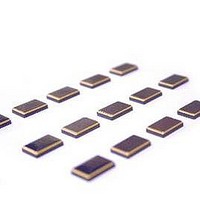TR7001 RFM, TR7001 Datasheet - Page 5

TR7001
Manufacturer Part Number
TR7001
Description
RF Transceiver 3G ASH Transceiver 315 MHz 115.2 kbps
Manufacturer
RFM
Datasheet
1.TR7001.pdf
(15 pages)
Specifications of TR7001
Wireless Frequency
315 MHz
Output Power
10 mW
Mounting Style
SMD/SMT
Package / Case
SM3-20H
Modulation
OOK/ASK
Lead Free Status / RoHS Status
Lead free / RoHS Compliant
Receiver Chain
The output of the SAW filter drives amplifier RFA1. This amplifier includes
provisions for detecting the onset of saturation (AGC Set), and for switch-
ing between 35 dB of gain and 5 dB of gain (Gain Select). AGC Set is an
input to the AGC Control function, and Gain Select is the AGC Control
function output. ON/OFF control to RFA1 (and RFA2) is generated by the
Pulse Generator & RF Amp Bias function. The output of RFA1 drives the
SAW delay line, which has a nominal delay of 0.5 µs.
The second amplifier, RFA2, provides 51 dB of gain below saturation. The
output of RFA2 drives a full-wave detector with 19 dB of threshold gain.
The onset of saturation in each section of RFA2 is detected and summed
to provide a logarithmic response. This is added to the output of the full-
wave detector to produce an overall detector response that is square law
for low signal levels, and transitions into a log response for high signal lev-
els. This combination provides excellent threshold sensitivity and more
than 70 dB of detector dynamic range. In combination with the 30 dB of
AGC range in RFA1, more than 100 dB of receiver dynamic range is
achieved.
The detector output drives a gyrator filter. The filter provides a three-pole,
0.05 degree equiripple low-pass response with excellent group delay flat-
ness and minimal pulse ringing. The 3 dB bandwidth of the filter can be set
from 4.5 kHz to 1.8 MHz with an external resistor.
The filter is followed by a base-band amplifier which boosts the detected
signal to the BBOUT pin. When the receiver RF amplifiers are operating at
a 50%-50% duty cycle, the BBOUT signal changes about 10 mV/dB, with
a peak-to-peak signal level of up to 450 mV. For lower duty cycles, the
mV/dB slope and peak-to-peak signal level are proportionately less. The
detected signal is riding on a 1.5 Vdc level that varies somewhat with sup-
ply voltage, temperature, etc. BBOUT is coupled to the CMPIN pin, or to
an external data recovery process (DSP), by a series capacitor. The cor-
rect value of the series capacitor depends on data rate, data run length,
and other factors as discussed in the ASH Transceiver Designer’s Guide.
RF Monolithics, Inc.
RFM Europe
©1999 by RF Monolithics, Inc. The stylized RFM logo are registered trademarks of RF Monolithics, Inc.
ESD
Choke
Antenna
RFIO
VCC1: Pin 2
VCC3: Pin 3
VCC2: Pin 16
GND1: Pin 1
GND2: Pin 10
20
Power Down Control
CR Filter
SAW
Phone: (972) 233-2903
Phone: 44 1963 251383
RFA1
TXA2
R
TXM
MOD
TX
8
Programming
TRL1
Control
X
X
CN
and
17
TRL0
CN
Master Oscillator
Pulse Generator
Local Oscillator,
& RF Amp Bias
Compensated
18
Temperature
Delay Line
FGR
SAW
CN
TXA1
19
15
3G ASH Transceiver Block Diagram
RFA2
Gain Select
AGC Set
Fax: (972) 387-8148
Fax: 44 1963 251510
Log
Detector
Control
AGC
LPFADJ
Figure 2
Low-Pass
Filter
9
R
AGC Reset
LPF
When an external data recovery process is used with AGC, BBOUT must
be coupled to the external data recovery process and to CMPIN by sepa-
rate series coupling capacitors. The AGC reset function is driven by the
signal applied to CMPIN.
Data Slicers
The CMPIN pin drives two data slicers, which convert the analog signal
from BBOUT back into a digital stream. The best data slicer configuration
depends on the system operating parameters. Data slicer DS1 is a capac-
itively-coupled comparator with provisions for an adjustable threshold.
DS1 provides the best performance at low signal-to-noise conditions. The
threshold, or squelch, offsets the comparator’s slicing level from 0 to 90
mV, and is set with a resistor between the RREF and THLD1 pins. This
threshold allows a trade-off between receiver sensitivity and output noise
density in the no-signal condition. For best sensitivity, the threshold is set
to zero but a minimum R
used for proper AGC action. In this case, noise is output continuously
when no signal is present. This, in turn, requires the circuit being driven by
the RXDATA pin to be able to process noise (and signals) continuously.
This can be a problem if RXDATA is driving a circuit that must sleep when
data is not present to conserve power, or when it its necessary to minimize
false interrupts to a multitasking processor. In this case, noise can be
greatly reduced by increasing the threshold level, but at the expense of
sensitivity. In order to guarantee THLD1 to be the value calculated, the
device should not be powered up in the receive mode. It should be pow-
ered up in either the sleep mode or the transmit mode and then switched
to the recieve mode. The best 3 dB bandwidth for the low-pass filter is also
affected by the threshold level setting of DS1. The bandwidth must be
increased as the threshold is increased to minimize data pulse-width vari-
ations with signal amplitude.
BB
5
C
BBO
6
BBOUT
PKDET
Detector
Peak
AGC
4
THLD1
C
PKD
TH1
Ref
13
Ref
value of approximately 20 K Ohms should be
R
Threshold
TH1
Control
DS2
DS1
E-mail: info@rfm.com
http://www.rfm.com
TR7001-11062007
11
dB Below
Peak Thld
R
Thld
REF
R
TH2
12
THLD2
AND
Baud Rate
Data/Clock
Recovery
Selection
14
7
RXDATA
RXDCLK
Page 5 of 15

















